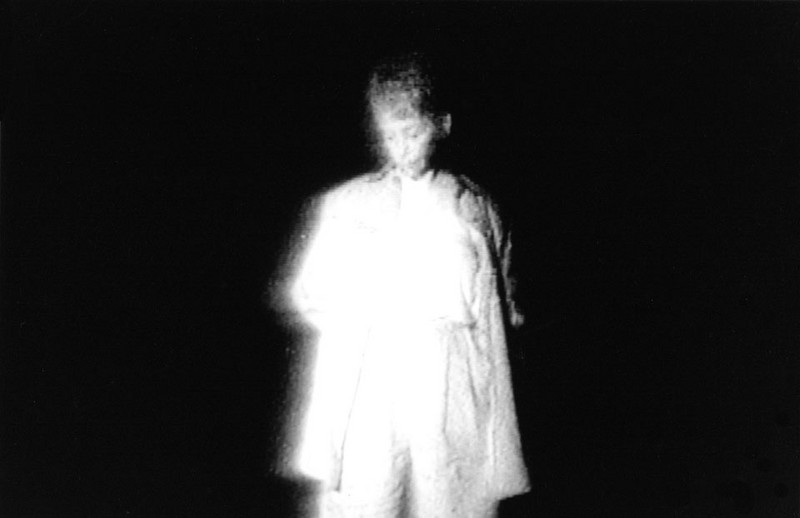Bill Viola
12 May - 28 Sep 2014
Vision as reception
Vision as reflection
Vision as projection
Bill Viola, note 1986
[in Robert Violette ed., Bill Viola, Reasons for Knocking at an Empty House, London 1995]
This special display of Bill Viola’s Tiny Deaths 1993 coincides with the installation of a new work by the artist in St Paul’s Cathedral entitled Martyrs (Earth, Air, Fire, Water).
Viola is a pioneer of video art, and has been one of its most important practitioners for more than forty years. Characteristic qualities of his work, such as the interplay between movement and stasis, and the testing of the viewer’s perception through multiple sensations, have become recurring elements of the medium as a whole.
Tiny Deaths was made in 1993. Barely visible figures are perceived in the darkened space until crescendos of light and sound bring moments of drama. The three projections envelop the viewer in the intense experience of the appearance and sudden disappearance of these presences. ‘The struggle we are witnessing today is not between conflicting moral beliefs’, Viola observed in 1992. ‘It is between our inner and our outer lives, and our bodies are the area where this belief is being played out.’ His works of the 1990s consistently show the body as the site for physical transformations – often through immersion in light or water – that embody these profound concerns with transformation and mortality.
While Tiny Deaths opens up broad possibilities around the meaning and transience of existence, Viola’s recent works address spiritual themes more directly. Martyrs (Earth, Air, Fire, Water), installed in St Paul’s Cathedral, and soon to be accompanied by the related work Mary, epitomises his ability to bring a full command of contemporary technology to engage timeless questions of belief.
Distance and nearness are attributes of bodies
The journeyings of spirits are after another sort.
You journeyed from the embryo state to rationality
without footsteps or stages or change of place,
The journey of the soul involves not time and place.
And my body learnt from the soul its mode of journeying,
Now my body has renounced the bodily mode of journeying.
It journeys secretly and without form, though under a form.
Jallaludin Rumi (1207-73), The Masnavi
[extracted in Robert Violette ed., Bill Viola, Reasons for Knocking at an Empty House, London 1995]
The body as the unconscious.
The body as mind.
Landscape as the body.
The mind as landscape.
The dissolution of the self in the breakdown
of inside/outside.
The skin as conceptual membrane.
Pain as knowledge.
Pain as beauty.
Satisfaction as stupification (as catatonia).
The mortification of the appetites.
Bill Viola, note,1 January 1987
[in Robert Violette ed., Bill Viola, Reasons for Knocking at an Empty House, London 1995]
Bill Viola was born in 1951 in Queens, New York. He lives and works in Long Beach, California.
Vision as reflection
Vision as projection
Bill Viola, note 1986
[in Robert Violette ed., Bill Viola, Reasons for Knocking at an Empty House, London 1995]
This special display of Bill Viola’s Tiny Deaths 1993 coincides with the installation of a new work by the artist in St Paul’s Cathedral entitled Martyrs (Earth, Air, Fire, Water).
Viola is a pioneer of video art, and has been one of its most important practitioners for more than forty years. Characteristic qualities of his work, such as the interplay between movement and stasis, and the testing of the viewer’s perception through multiple sensations, have become recurring elements of the medium as a whole.
Tiny Deaths was made in 1993. Barely visible figures are perceived in the darkened space until crescendos of light and sound bring moments of drama. The three projections envelop the viewer in the intense experience of the appearance and sudden disappearance of these presences. ‘The struggle we are witnessing today is not between conflicting moral beliefs’, Viola observed in 1992. ‘It is between our inner and our outer lives, and our bodies are the area where this belief is being played out.’ His works of the 1990s consistently show the body as the site for physical transformations – often through immersion in light or water – that embody these profound concerns with transformation and mortality.
While Tiny Deaths opens up broad possibilities around the meaning and transience of existence, Viola’s recent works address spiritual themes more directly. Martyrs (Earth, Air, Fire, Water), installed in St Paul’s Cathedral, and soon to be accompanied by the related work Mary, epitomises his ability to bring a full command of contemporary technology to engage timeless questions of belief.
Distance and nearness are attributes of bodies
The journeyings of spirits are after another sort.
You journeyed from the embryo state to rationality
without footsteps or stages or change of place,
The journey of the soul involves not time and place.
And my body learnt from the soul its mode of journeying,
Now my body has renounced the bodily mode of journeying.
It journeys secretly and without form, though under a form.
Jallaludin Rumi (1207-73), The Masnavi
[extracted in Robert Violette ed., Bill Viola, Reasons for Knocking at an Empty House, London 1995]
The body as the unconscious.
The body as mind.
Landscape as the body.
The mind as landscape.
The dissolution of the self in the breakdown
of inside/outside.
The skin as conceptual membrane.
Pain as knowledge.
Pain as beauty.
Satisfaction as stupification (as catatonia).
The mortification of the appetites.
Bill Viola, note,1 January 1987
[in Robert Violette ed., Bill Viola, Reasons for Knocking at an Empty House, London 1995]
Bill Viola was born in 1951 in Queens, New York. He lives and works in Long Beach, California.

